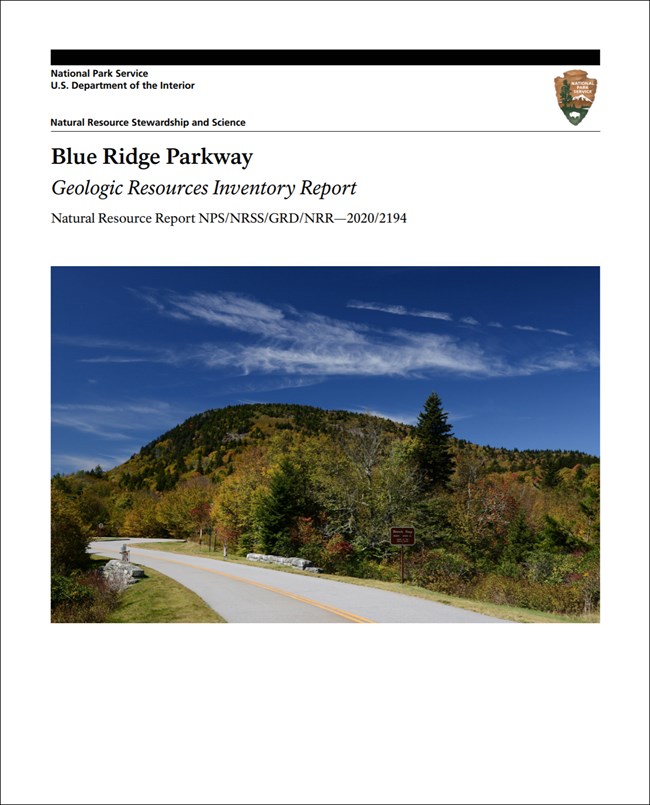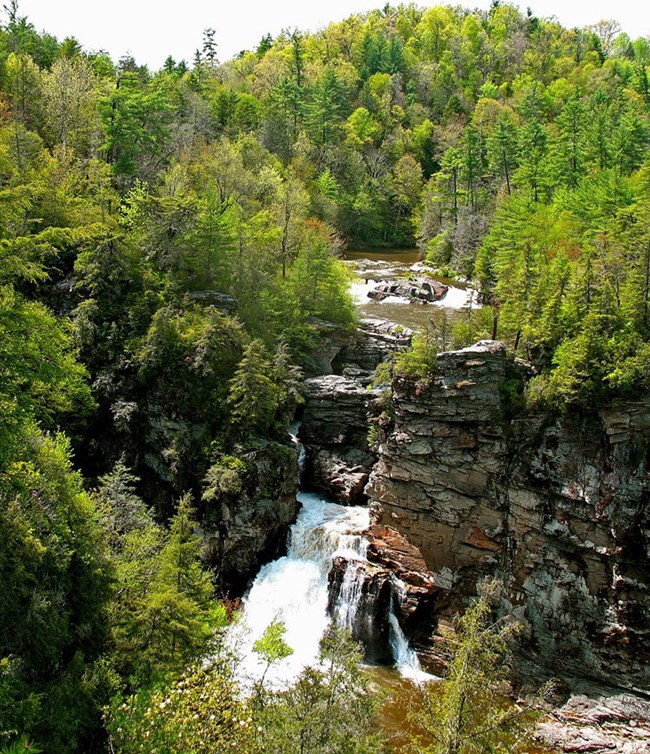Last updated: June 17, 2024
Article
NPS Geodiversity Atlas—Blue Ridge Parkway, North Carolina and Virginia
Geodiversity refers to the full variety of natural geologic (rocks, minerals, sediments, fossils, landforms, and physical processes) and soil resources and processes that occur in the park. A product of the Geologic Resources Inventory, the NPS Geodiversity Atlas delivers information in support of education, Geoconservation, and integrated management of living (biotic) and non-living (abiotic) components of the ecosystem.

Introduction
Blue Ridge Parkway (BLRI) is the longest road to be designated as a single park unit in the United States and stretches a scenic 756 km (470 mi) through North Carolina (Allegheny, Ashe, Avery, Buncombe, Burke, Haywood, Henderson, Jackson, McDowell, Mitchell, Surry, Swain, Transylvania, Watauga, Wilkes, and Yancey Counties) and Virginia (Amherst, Augusta, Bedford, Botetourt, Carroll, Floyd, Franklin, Grayson, Nelson, Patrick, Roanoke, and Rockbridge Counties). Authorized as an NPS unit on June 30, 1936, BLRI connects Great Smoky Mountains National Park with Shenandoah National Park and ties together a diverse landscape that includes high passes, lush vegetation, waterfalls, water and wind gaps, forests, and upland meadows (Thornberry-Ehrlich 2020). Construction began on the parkway during the Great Depression to create jobs in an impoverished area. The parkway is regarded as an engineering marvel that includes 26 tunnels and 168 bridges designed in harmony with the local bedrock (Thornberry-Ehrlich 2020).
Geologic Setting
The geology of BLRI consists of ancient rocks that form the core of the Appalachian Mountains and date back more than one billion years. The long geologic history recorded in the rocks along BLRI involves an early supercontinent (Rodinia), the opening and closing of an ancient ocean to form another supercontinent (Pangea), and rifting that formed the Atlantic Ocean (Thornberry-Ehrlich 2020). Rocks along the parkway are broadly divisible into six groups based on age and rock type: (1) Mesoproterozoic basement complex (more than 1 billion years old), (2) Neoproterozoic metasedimentary and metaigneous complexes (more than 539 million years old), (3) Neoproterozoic to Cambrian sedimentary and metamorphic rocks (between 1 billion and 487 million years old), (4) Paleozoic sedimentary and mylonitic rocks, (5) Jurassic igneous rocks (more than 143 million years old), and (6) Cenozoic surficial deposits that are still forming on the landscape today (Thornberry-Ehrlich 2020).
Geologic Features and Processes
Features visible along the parkway include the following:
-
Blue Ridge, Black, Great Craggy, Pisgah, and Great Balsam Mountains
-
Gaps
-
Faults and Folds
-
Bedrock Exposures: Sedimentary, Igneous, and Metamorphic Rocks
-
Earth Surface Processes: Surficial Units
-
Wetlands
Geoconservation
Those varied geologic features and processes also create a multitude of resource management issues for park staff, including:
-
Geologic Hazards (slope movements and earthquakes)
-
Abandoned Mineral Lands
-
Disturbed Lands Restoration and Structural Integrity of the Parkway
- Paleontological Resource Inventory, Monitoring, And Protection
Learn more about NPS programs for geologic resource management on these websites: [Geoconservation Programs] [Geohazards] [Fossil Stewardship] [Cave Resources Stewardship]
Regional Geology
Driving down the Blue Ridge Parkway is to, by design, follow the trace of the Blue Ridge Physiographic Province and experience the beautiful landscapes associated with the core of a massive ancient mountain range. Rocks visible along the way span more than a billion years of earth's history. Blue Ridge Parkway is a part of the Blue Ridge, Peidmont, and Valley and Ridge Physiographic Provinces and shares its geologic history and some characteristic geologic formations with a region that extends well beyond park boundaries.
- Scoping summaries are records of scoping meetings where NPS staff and local geologists determined the park’s geologic mapping plan and what content should be included in the report.
- Digital geologic maps include files for viewing in GIS software, a guide to using the data, and a document with ancillary map information. Newer products also include data viewable in Google Earth and online map services.
- Reports use the maps to discuss the park’s setting and significance, notable geologic features and processes, geologic resource management issues, and geologic history.
- Posters are a static view of the GIS data in PDF format. Newer posters include aerial imagery or shaded relief and other park information. They are also included with the reports.
- Projects list basic information about the program and all products available for a park.
Source: NPS DataStore Saved Search 2725. To search for additional information, visit the NPS DataStore.
A NPS Soil Resources Inventory project has been completed for Blue Ridge Parkway and can be found on the NPS Data Store.
Source: NPS DataStore Saved Search 2777. To search for additional information, visit the NPS DataStore.
GRI Geology Image Gallery

Related Links
